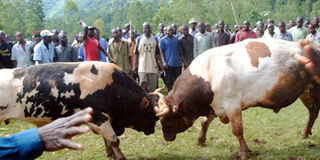Bull fights: An exciting tourism gem

Bulls tussle it out as revellers cheer on at Namasho grounds in Bulucheke Sub-county, Bududa District last Saturday.
PHOTO by Smartin ssebuyira
What you need to know:
Patrick Kakaire, a tour operator with Kaka Tours in Mbale District, says the sport is fun and relatively safe, although a bull injured one of the spectators in 2011
Adventure.
Though often associated with foreign countries, the bull fighting sport is slowly gaining tourism importance in Uganda, as Saturday Monitor’s Martin Ssebuyira found out.
The bullfighting sport is often associated with countries like Spain, South America and France. A recent visit to Namasho grounds in Bulucheke Sub-county in Bududa District, a place that has been in the media over landslides, brought me face to face with this tradition in Uganda, and it was quite an unforgettable experience. From as early as 9am every Saturday, people start gathering around
Namasho and arguing about which bull will emerge victorious while staking money.
The bulls, mostly cross-breeds, are slowly led to the ground that is also the battlefield. On arrival, they start charging by forcing their horns in the ground.
Wilson Nambaale, a resident, looks forward to these games. “We have grown up loving and enjoying the event. It is our Cineplex (movie cinema) every Saturday and we don’t want it to die,” he says.
Ahmed Mukhooli, another reveller, adds: “It helps our bulls to get strong and not disturb us. It is fun and it helps to bring us together and it’s a major social event.”
Participants and viewers come from as far as Bubita, Bukalasi, Buwali, Bukikayi, Bushiki, Bumayoka, Mabono, Bushiyi sub-counties with bulls trained to fight.
Importance of the fights
According to Constant Matuhu, the chairperson Bullfighting Association, who doubles as a bull trainer, from the 1950s, bull fights have been held for entertainment and enriching the animals.
“The fights improve their appetite, build their necks and chests, and help them work off excess energy, thus stopping them from being destructive and hostile,” he says. He was elected chairman during one of the fights in the 1960s after an experience that set him aside. He managed to stop a fight among bulls with ease, while others had failed.
According to Matuhu, the sport started as a result of fights between communities over a salty water source in Namasho.
“People used to fight and kill each other but after some years, they resolved to share the little available water but left the animals to fight for entertainment,” he reveals.
The referees normally gauge the sizes of the animals to fight depending on the size of the bull.
More than 1,000 people gather to cheer up the event. About two to three pairs of bulls fight at once, with animal owners keeping a close watch and cheering on their animals.
The sport is also part of the Bamasaaba’s cultural heritage that has been in existence since the 1950s. Spectators carry containers of local brew, which they take while watching the fights. Elders pray to their gods before the fight as a symbol of respect to the forefathers, who they believe initiated the sport.
The bull that emerges the strongest is named after the strongest leaders in the world and its owner gets small cash prizes from the community bets. Winners receive between Shs5,000 to Shs20,000, depending on what has been availed. On good days, local politicians stake as much as Shs500,000 for the winners.
The animals, according to Matuhu, can be a danger to their owners and could destroy the place where they are kept should they remain idle for more than two weeks.
Aidah Wetungu, the Chairperson Eastern Tourism Forum, says the animals are first trained from as early as two years.
“It was just used for entertainment but during the battles, it became an advertisement forum where they used to spot the biggest animals and buy them off,” she says.
A fighter bull can weigh as much as 500kg to 800kg. She says they want to promote the sport as a tourism product to attract tourists so people in the community can earn a living. “This can be a community tourism event in Uganda. In future, we want to set up an arena and charge entrance fees for the bull owners to fully gain out of this sport,” she added.
Patrick Kakaire, a tour operator with Kaka Tours in Mbale District, says the sport is fun and relatively safe, although a bull injured one of the spectators in 2011.
About the bull fights
The shows. The fights are held every Saturday at Namasho grounds, Bulucheke Sub-county in Bududa District.
Getting there. From Kampala, a bus to Mbale will set you back by about Shs15,000. One can then takes a taxi from Mbale Town to Bududa at Shs4,500 and walk to Namasho grounds. Tour companies operating in the area charge between Shs20,000 to Shs50,000.




